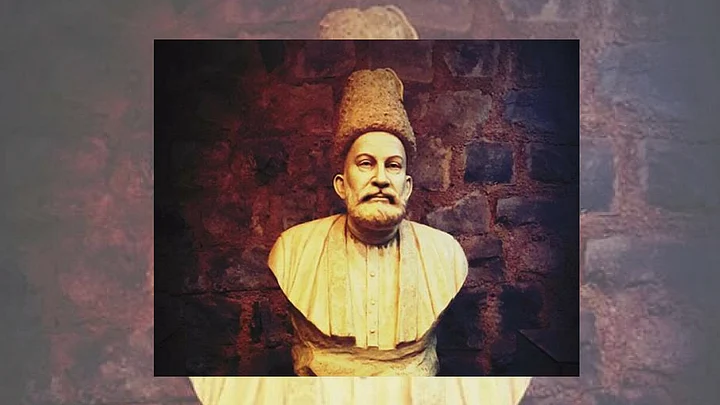On Purani Delhi’s Chandni Chowk, a faint scent of poesy is in the air today.
The barsi (15 February) of the super-legendary poet Mirza Ghalib, just a year away from his 150th, will be remembered to a muted degree at his little haveli in Gully Qasim Jaan, Ballimaran, of old Delhi.
No grand mehfil, no soiree of the cultural kind – except a couple of events by poetry connoisseurs – is being hosted in the capital for the bard on the heels of Valentine’s day and the just-about concluded Art Summit.
The haveli where Mirza Asadullah Baig Khan (1797-1869) spent his spent his last years, could have been developed into a prime tourist-spot over the decades. Consolably, the Archaeological Survey of India has preserved a sizable section of the hallowed spot, but that’s about it. Throughout the year, visitors, from India or overseas, are a scarce few. At any point of the week, the 110-square-foot, two-room haveli wears a forlorn, tired look.
Gifted to Ghalib by an admirer -- a hakim -- the haveli was sold circa 1964 for a piffling Rs 24,000. On the passing away of its owner, it was used to store sacks of coal and then served as a venue for wedding receptions. Eventually, it was restored by the central government in 1999.
Right in the midst of a centuries-old market of mutton, fish, vegetables and groceries, the haveli is an ironical comment on the penury-stricken life of Ghalib, who it is lored often didn’t know where his next meal was coming from.
So much for the chequered life of the shaayar’s aashiana. At a time, when the Urdu kalam is a rarity, when Muslim characters are being demonised by populist cinema, can there be a revival of the Mirza Ghalib movement?
The Sohrab Modi-directed 1954 biopic featuring Bharat Bhushan and Suraiya as the poet’s courtesan love, Chandni, is remembered, especially for its evocative ghalzal-laden music score by Ghulam Mohammed.
As much, if not more, Gulzar’s TV series (1988), with Naseeruddin Shah in the eponymous role of Mirza Ghalib, is recalled as one of the most quality-conscious productions of Doordarshan. The music score was by Jagjit and Chitra Singh.
Incidentally, Sanjeev Kumar was to portray the bard but passed away before the project could fructify.
Another Ghalib biopic (1961), remarkable for its music score by Tassaduq Hussain, had been essayed by director Billoo Mehra in Pakistan, toplining Sudhir and Noor Jehan.
Now let’s consider this for a moment: would Doordarshan or for that matter, any TV/ satellite/ streaming channel greenlight a project on Ghalib today? Banish the thought.
Would any filmmaker venture out on poetry route today? Unthinkable, simply because such endeavours would per force be a paean to the imperishable art of Urdu poetry, complete with a sub-text of political commentary.
In fact, Muslim characters in central roles are fast vanishing from the high-profile feature films, TV and web-series in the works. In this context, it could be argued that Ekta Kapoor of Balaji Motion Pictures has just announced the umpteenth remake of Laila Majnu, the star-crossed lovers enacted earlier by Shammi Kapoor and Nutan in 1953, and by Rishi Kapoor-Ranjita in ’76.
Clearly, a re-read of the Romeo and Juliet genre is safe material. Not so, Ghalib’s life and times which were anguished.
Take the lines, “Ragon mein daudte phirne ke hum nahin qaa’il/ Jab aankh hi se na tapka to phir lahoo kya hai..” ( “Merely because it courses through the veins I’m not convinced/if it drips not from my eyes blood cannot be true”).
Generally regarded as a Romantic poet, Ghalib’s sense of personal despair is timeless, extending to the subversive. Indeed, Ghalib’s verses have taken on a universal resonance encompassing the times he lived in, as well as the here and now. In hindsight, tolerance -- live and let live – was his credo.
That Mirza Ghalib’s influence is largely confined to connoisseurs of poetry from the older -- immediate pre- and post-Independence era generations – has to be accepted. Yet I dare say this, he continues to be a brand-name.
Believe it or not, in the sprawling metropolis of Mumbai, you can find a Mirza Ghalib municipal market in the congested neighbourhood of Null Bazaar. Plus,there’s a Ghalib Road close to Cheetah Camp in the eastern suburbs of Trombay. Mercifully, the names have been retained.
Back to the haveli in Delhi’s Ballimaran, the memorial certainly needs to be updated with interactive technology and consistent promotion to attract tourists. Currently, besides the poet’s bust, handwritten letters, household utensils, a hookah, framed stanzas of his shayari, as well as portraits his contemporaries Ustad Zauq, and miscellaneous bric-a-brac are on display.
Not enough in this day and age, when even attempts at amateur art and poetry are presented at galleries with a flourish in video formats and installations.
Any form of plea for a Ghalib revival – from individual devotees, scholars and organised groups – amounts to a voice in the wilderness. Face it: Urdu poetry has not been a cultural priority with the powers-that-be, today or yesterday, irrespective of political ideology.
That’s just the way it is. In the words of Ghalib then:
Yeh na thi hamari qismat ki visaal-e-yaar hota
Agar aur jeete rehte yahi intezar hota
(That my love be consummated fate did not ordain
Living longer had I waited, it would have been in vain.)
(The writer is a film critic, filmmaker, theatre director and a weekend painter.)
